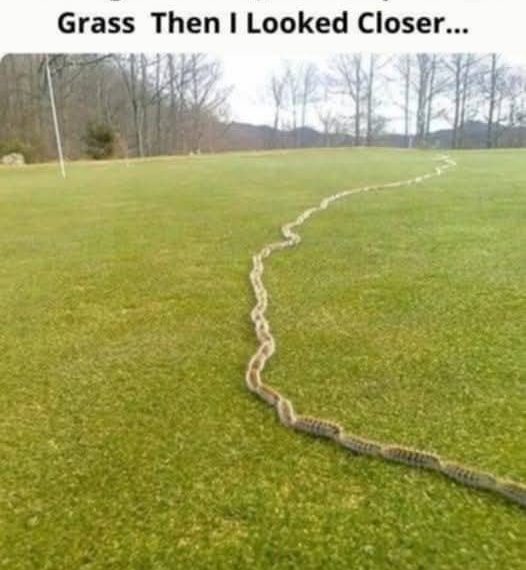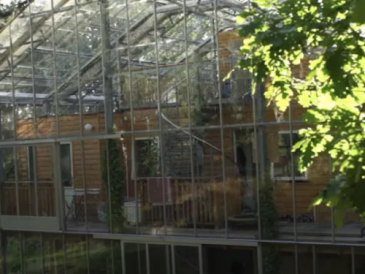🌿 I Thought It Was a Rope. What I Found in My Backyard Left Me Speechless (and Slightly Concerned)
We all know how nature has its ways of surprising us… but nothing prepared me for what I saw lying still on my backyard lawn.
At first, I assumed it was just a piece of rope. Maybe something from the garden tools, or some twine left behind after the last round of weeding. But something about it didn’t look quite right. The way it lay there—half on the grass, half on the patio stone—it almost looked alive.
Then a thought struck me like lightning:
“Wait… is that a snake?!”
Instant anxiety. My heart pounded. I stepped back, grabbed my phone (ready to call a local pest control service), and crept in for a closer look.
But what I discovered was even more unexpected…
It Wasn’t a Snake. It Wasn’t a Rope Either.
What I found was a long, slow-moving column of caterpillars—dozens, possibly over a hundred—crawling in a perfect, single-file line across my yard.
No gaps. No swerving. Just a neat, tidy march, as if they were on a mission. It was almost hypnotic.
And here’s the thing: I didn’t even know caterpillars could do that.
🤔 Why Were These Caterpillars Traveling in a Perfect Line?
After some quick research (and a few messages to my eco-savvy gardening friend), I learned this fascinating behavior is called a “caterpillar train” or processionary behavior.
It turns out, some species—like the pine processionary caterpillar—are known for this exact phenomenon. And there are a few theories as to why they do it:
- 🛡 Predator Protection: By moving together in one long line, they look like a bigger animal, making them less attractive to birds or pests.
- 🧭 Chemical Navigation: The leading caterpillar lays down a pheromone trail. The others follow it, keeping them together and on the right path.
- 🔋 Energy Efficiency: Similar to how cyclists draft behind one another, those in the line might conserve energy.
It’s an incredible example of instinct and organization in the insect world—and a powerful reminder of how nature adapts for survival.
🚫 Should You Be Worried?
Here’s the part that made me pause.
Some caterpillar species, like the pine processionary moth, can be dangerous. Their tiny hairs contain toxic proteins that can cause skin irritation in humans—and serious health risks to pets.
So if you ever spot a similar line in your garden or near trees:
- 🐕 Keep your pets away.
- 🧤 Wear gloves if you must remove them.
- 📞 Contact a local pest control service if you’re unsure.
It’s also a good idea to check your trees for infestations, especially if you live in regions where these caterpillars are common. In some cases, you may need to invest in tree removal services or professional insect control treatments to prevent further spread.
🌿 How to Prevent Caterpillar Infestations Naturally
If you prefer eco-friendly pest control (like I do), there are some natural strategies that help keep unwanted insects out of your garden:
✅ Neem oil spray – A powerful natural insect repellent that deters many pests, including caterpillars.
✅ Plant herbs like basil, lavender, and mint – Not only do they smell amazing, but they repel many garden pests.
✅ Diatomaceous earth – A fine powder that’s harmless to humans but deadly to crawling insects. It’s a staple in organic gardening.
✅ Keep your lawn trimmed – Long grass can attract all kinds of pests. Regular lawn care reduces hiding places.
✅ Remove standing water – This helps prevent mosquitoes and other larvae-based pests.
And don’t forget: a healthy garden starts with healthy soil. Enriching it with natural compost and maintaining proper irrigation can also keep pest populations in check.
💡 Final Thoughts: Nature Is Wiser Than We Think
What began as a backyard mystery quickly turned into a mini science lesson—and a wake-up call about the importance of observing the signs nature gives us.
The next time you see something odd in your yard, don’t just brush it off. It might be a rare behavior like caterpillar procession, or a warning sign of a larger issue like a termite infestation, moth larvae outbreak, or other hidden problems.
And if you’re ever unsure, don’t hesitate to get expert help. Your backyard might look peaceful—but beneath the surface, there’s often a whole ecosystem at work.
📌 Bonus: What to Do If You Find a Caterpillar Train
- Don’t touch it bare-handed
- Keep kids and pets away
- Identify the species if possible
- Use natural pest deterrents or call professional pest removal services
- Monitor nearby plants and trees for signs of infestation
🌱 Have you ever witnessed anything like this?
Share your story in the comments—and tag a friend who would be fascinated (or creeped out) by a caterpillar train!





